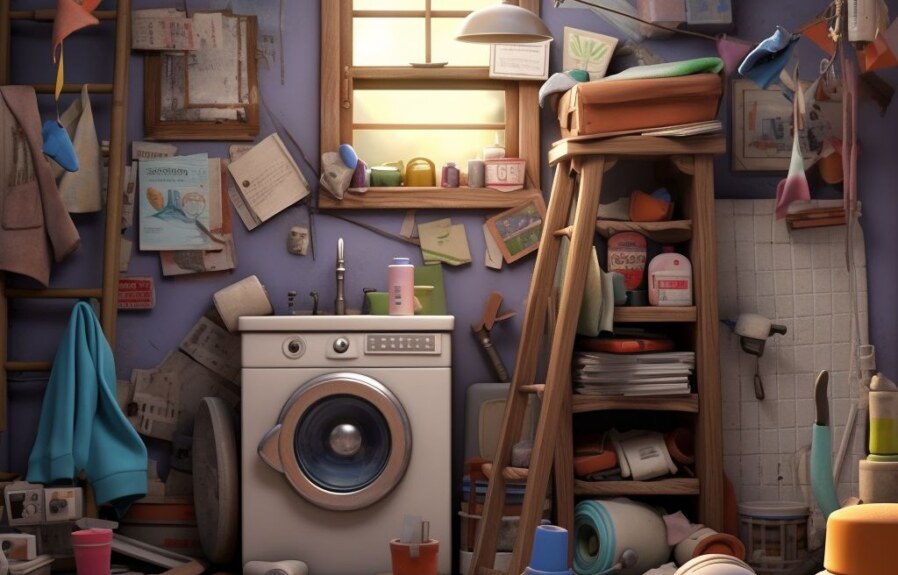When doing laundry, it’s important to have a reliable and efficient dryer that produces minimal lint and moisture build-up. But what do you do when your laundry room is located in the middle of your home? Venting a dryer in this scenario can be a daunting task, but it’s not impossible. In this article, we’ll explore how to properly vent a dryer in the middle of your house and what types of techniques and materials are necessary for a safe and successful installation. Whether you’re a seasoned DIYer or a beginner, this guide will provide you with all the information you need to efficiently and safely vent your dryer in the middle of your home.
1. Why a Properly Ventilated Dryer is Essential in the Middle of Your Home
If you have your dryer in the middle of your house, proper ventilation is critical to maintain the safety and health of your family. A dryer that is not correctly vented can lead to a build-up of lint, which can become a fire hazard. Moreover, moist and warm air that accumulates in the home due to a poorly ventilated dryer can result in mold growth that can potentially affect the overall health of your family.
To avoid these potential hazards, it is essential to have a proper ventilation system in place for your dryer. Not only does this help in mitigating safety and health risks, but it also prolongs the life of your dryer. When a dryer operates without proper ventilation, the parts and components inside can become overheated, leading to malfunctions and even complete failure.
Therefore, having a properly ventilated dryer at home should be one of your top priorities. In the following sections, we will guide you through the process of selecting the right location for your dryer, installing a ventilation system in the middle of your house, maintaining proper ventilation, and avoiding potential hazards that come with a poorly ventilated dryer.
2. Choosing the Right Location for Your Dryer to Maximize Ventilation
Choosing the perfect location to place your dryer in the middle of your home for maximum ventilation can be challenging. A proper location with proper ventilation reduces the risk of potential hazards that come with poor ventilation. Follow these tips to ensure your dryer is in the right location.
1. Check the Building Codes:
Check your building codes to ensure that you can put a dryer in the middle of your home. Some associations may have rules or regulations against the installation, while others may have guidelines concerning the ideal location for your dryer and its ventilation system.
2. Choose a Central Location:
Select a central location within your home since it is the most comfortable for the ducting to flow from the dryer to the vent. Try to locate a spot that does not obstruct foot traffic in the home. By doing this, you can keep your air conditioning system efficient and hinder potential inconveniences in your home.
3. Plan for Maximum Ventilation:
When selecting the ideal location for your dryer, keep in mind that proper ventilation is essential. Make sure the dryer is located in a spot that provides excellent ventilation. You can install a dryer volume booster fan that increases low pressure through the ductwork and enables proper air flow.
By following these three important tips, you will choose the best location to put your dryer in your middle home for maximum ventilation. The placement process takes time, and there are many things to consider, but with proper ventilation, you can ensure that your home stays safe.
3. Step-by-Step Guide for Installing a Ventilation System in the Midst of Your Home
Installing a ventilation system for your mid-home dryer may seem like a challenging task, but it’s not impossible. This guide will walk you through the steps to properly install a ventilation system in the midst of your home, ensuring that your dryer runs efficiently and safely.
Step 1: Gather the necessary materials
To install a ventilation system for your mid-home dryer, you will need the following materials:
- Flexible ductwork
- Dryer vent hood
- Drill and screwdriver
- Tape measure
- Pencil
- Vent clamp
- Wall cap
- Metal dryer pipe
Step 2: Find the right location for your dryer vent
The location of your dryer vent is crucial, as it needs to be properly ventilated to prevent potential fire hazards. Choose a location that’s near an exterior wall, and easily accessible from the dryer.
Step 3: Install the vent hood and wall cap
Attach the vent hood to the exterior wall using a vent clamp, screwdriver, and drill. Mark the location of the wall cap on the interior wall, and drill a hole for the metal pipe.
Step 4: Connect the flexible ductwork
Attach the flexible ductwork to the vent hood and wall cap, tightening the connections with metal clamps. Avoid using screws, as they can catch lint and reduce airflow.
Step 5: Test your ventilation system
Once you’ve installed the ventilation system, test it for any leaks or malfunctions. Turn on the dryer and feel for the airflow outside, ensuring that the system is properly ventilating the dryer.
By following these steps and properly installing a ventilation system for your mid-home dryer, you can ensure that you minimize the risk of potential hazards while keeping your dryer running efficiently.
4. Maintaining Proper Ventilation in Your Mid-Home Dryer: Tips and Tricks
Proper ventilation ensures that your dryer runs efficiently and effectively. It also reduces the risk of dangerous fires caused by flammable lint building up in your dryer’s vent. Here are some tips and tricks for maintaining proper ventilation in your mid-home dryer:
Clean the Ventilation System Regularly
Buildup of lint and debris is the main cause of dryer fires. Therefore, you should clean your dryer’s exhaust system at least once a year. The lint filter should also be cleaned before and after each use. Failure to do so can lead to poor ventilation and a higher risk of combustion.
Use the Correct Ventilation System
Choosing the right ventilation system is crucial for ensuring good airflow. The most common types of dryer vents are the rigid metal vent, the flexible metal vent, and the plastic vent. Although plastic vents are the cheapest option, they are not as durable and have a higher fire risk. Rigid metal vents are considered the safest, but flexible metal vents are more convenient to install and are better suited to tight spaces. Make sure to choose the right type of ventilation system that suits your dryer and home requirements.
Check the Ventilation System Regularly
Checking your ventilation system regularly is critical to maintaining good airflow. A clogged or damaged ventilation system can reduce your dryer’s efficiency and create a fire risk. Verify that the vent is free from blockages, dents, and other signs of damage. You can do this by running your dryer and checking the air flow outside the outlet.
Proper ventilation is essential for your mid-home dryer. Utilize these tips and tricks for maintaining good ventilation and reducing your risk of dryer-related fires.
5. Avoiding Potential Hazards of Poorly Ventilated Dryers in the Middle of Your Home
Ensuring proper ventilation for your dryer is not just about increasing its efficiency and achieving a faster drying time, but also about keeping your home safe. Here are some potential hazards you can avoid by having a properly ventilated dryer in the middle of your home.
Fire Hazards
A poorly ventilated dryer can lead to a build-up of lint that accumulates on the dryer’s filter, ducts, and inside the vent. The accumulation of lint is highly combustible and can ignite a fire, especially when exposed to high temperatures. According to the National Fire Protection Association, dryer vents that are not properly maintained are one of the leading causes of house fires in the United States.
High Energy Bills
When a dryer is not properly ventilated, the flow of air is restricted, which means that the dryer will have to use more energy to dry clothes. This puts a strain on your electricity bill and also leads to the wear and tear of your dryer. A properly ventilated dryer not only increases its efficiency and lifespan but also saves you money on energy bills.
Health Hazards
A poorly ventilated dryer can also lead to health hazards. The build-up of lint and moisture can create an ideal breeding ground for mold and mildew to proliferate. This can trigger allergies and respiratory problems. Additionally, poorly ventilated dryers can also produce carbon monoxide, a highly toxic gas that can pose as a serious health risk when inhaled in large quantities.
In conclusion, it is essential to make sure that your dryer is properly ventilated. By following the above-discussed tips, you can avoid potential hazards such as fire, high-energy bills, and health risks.
People Also Ask:
1. Can I vent my dryer inside the house?
It is not recommended to vent a dryer inside the house due to the potential risk of mold, mildew, and other hazards. It can also cause a fire hazard due to the buildup of lint.
2. How do I install a vent for a dryer in the middle of the house?
To install a vent for a dryer in the middle of the house, you will need to measure the distance between the dryer and the exterior wall. Cut a hole in the wall, attach the venting duct to the dryer, and extend it through the hole to the outside using a vent hood.
3. What type of vent should I use for my dryer?
It is recommended to use rigid metal venting duct, as it is less likely to collapse and restrict airflow. Flexible plastic or foil ducts are not recommended as they can be a fire hazard.
4. Can I use a roof vent for my dryer?
While it is possible to use a roof vent for a dryer, it is not recommended as it can be difficult to install and maintain. It is best to use a vent that goes straight out from the side of the house.
5. What are some common venting problems with dryers?
Some common venting problems with dryers include clogged ducts, improperly installed venting, and damaged or crushed ducts. These problems can cause poor drying performance, increased energy consumption, and potential fire hazards.
Conclusion:
Venting a dryer in the middle of the house may seem like a daunting task, but it is important to ensure that your dryer operates safely and efficiently. Using the proper venting materials and installation techniques can help prevent potential hazards and ensure that your dryer operates at its best. It is always recommended to consult a professional if you are uncertain about the installation process.



